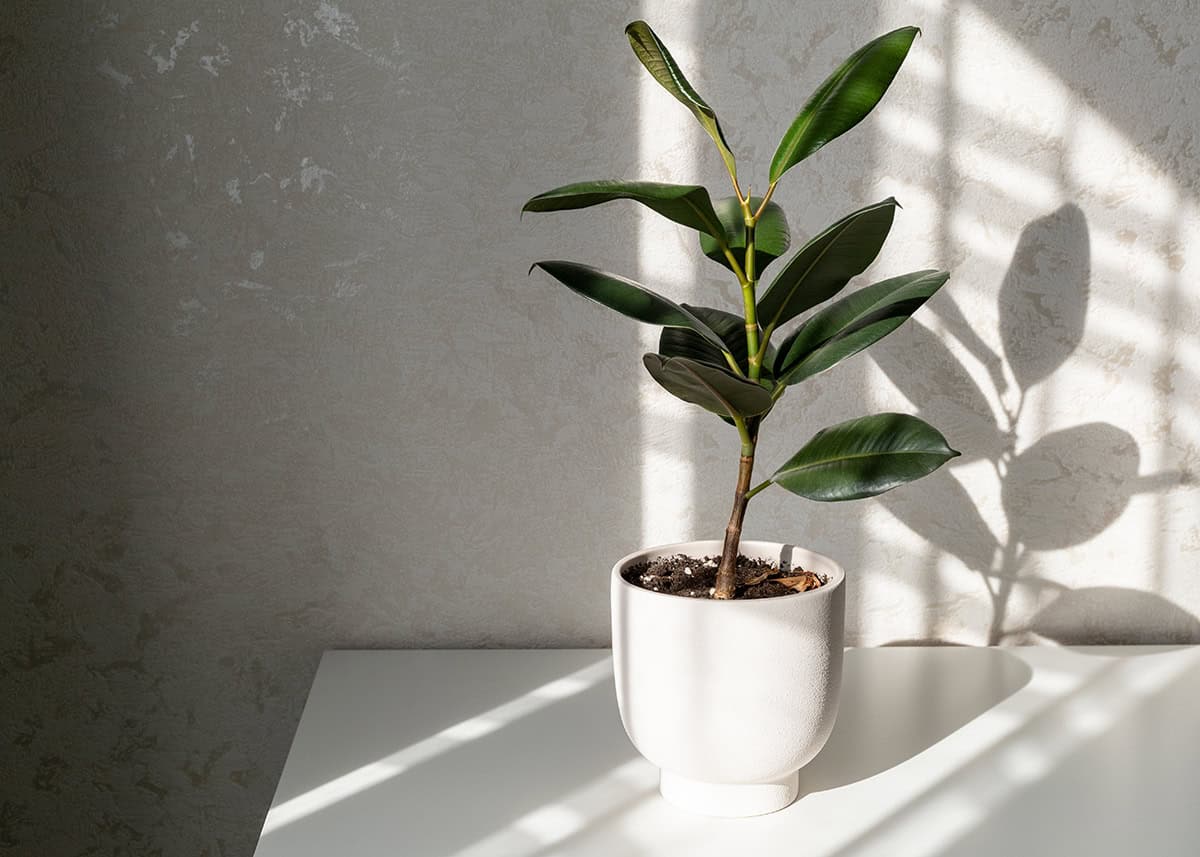You recently added a rubber plant to your living room, attracted by its glossy, deep green leaves. Now, you’re wondering how to keep it healthy and thriving. Caring for a rubber plant is straightforward with the right guidance. Gain the knowledge so your rubber plant flourishes and turns into a striking focal point in your home.
| Common Name | Rubber Plant |
| Botanical Name | Ficus elastica |
| Family | Moraceae |
| History & Origin | Native to Southeast Asia |
| Plant Type | Evergreen tree |
| Mature Size | 6-10 feet indoors, up to 100 feet outdoors |
| Sun Exposure | Bright, indirect light |
| Soil Type | Well-draining, loamy soil |
| Soil pH | 5.5-7.5 |
| Temperature | 60-75°F |
| Watering | Keep soil moist, less in winter |
| Fertilizing | Monthly during growing season |
| Bloom Time | Rarely blooms indoors |
| Flower Color | Inconspicuous, greenish |
| Hardiness Zone | 10-12 USDA |
| Toxicity | Toxic to pets if ingested |
| Common Problems | Overwatering, root rot, pests like spider mites |
Table of Contents
Light
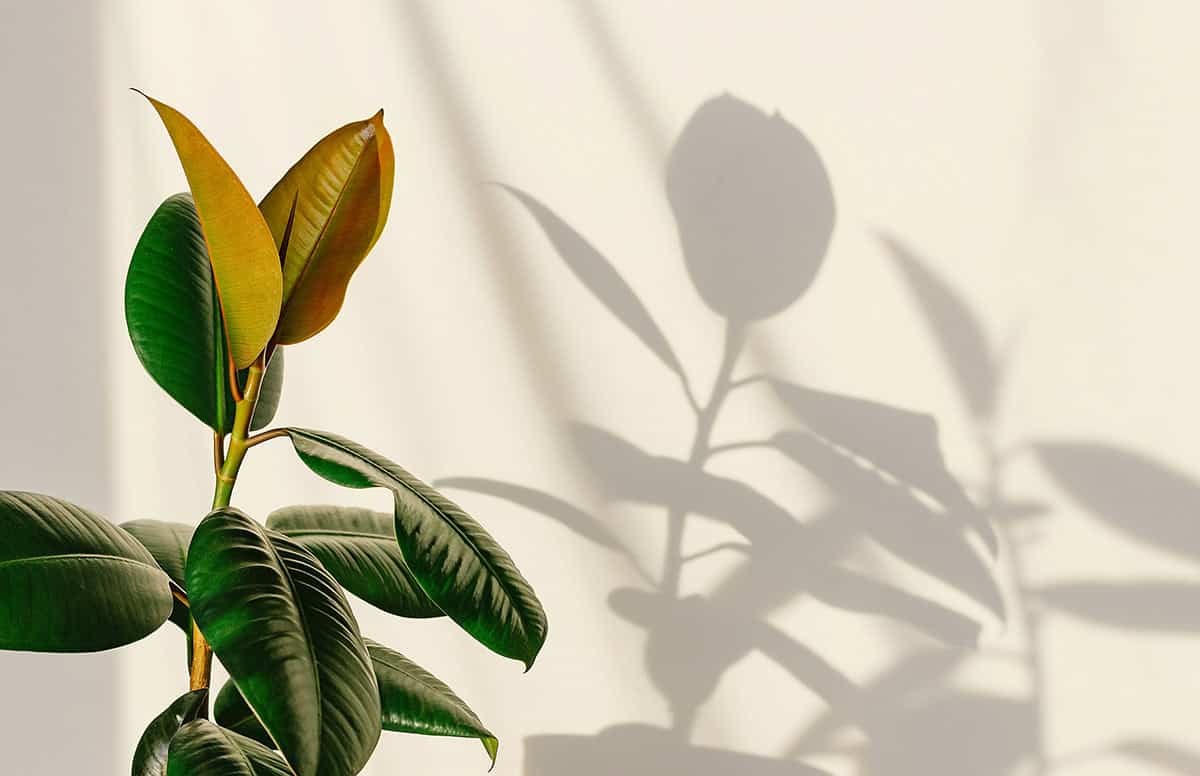
Your rubber plant thrives in bright light, but it’s also adaptable to low-light conditions. To provide the best environment for your plant, place it near an east-facing window. This way, it receives gentle morning light, which helps it grow optimally.
It’s crucial to protect your rubber plant from extreme temperature fluctuations. The ideal temperatures for its growth range from 60 to 65 °F at night and 75 to 80 °F during the day. Be cautious with temperatures lower than 55° F and avoid sudden drops in temperature, as well as cold drafts.
When limited light is available, consider using fluorescent lamps to supplement natural light. Providing your rubber plant with 12 to 16 hours of supplemental light daily can significantly improve its growth and overall health. In doing so, your plant will maintain a vibrant color, healthy leaves, and sturdy stems.
Soil
An ideal soil mix for Rubber Plants should contain equal parts of peat, loam, and perlite. This combination ensures proper drainage, aeration, and moisture retention, ultimately contributing to a thriving plant.
Be sure to use a high-quality potting mix if preparing the soil from scratch isn’t an option. To further enhance your Rubber Plant’s growth, you could consider adding a layer of organic matter, such as compost, which releases essential nutrients gradually.
While the Rubber Plant can adapt to a range of soil conditions, it is essential to monitor the soil’s pH level. Aim to maintain a slightly acidic pH between 6.0 and 6.5, as this ensures the plant can effectively absorb nutrients. Additionally, regularly check for waterlogging, which can lead to root rot. To avoid this issue, plant your Rubber Plant in a pot with drainage holes, promoting a healthier root system.
Keep an eye on the soil, and notice when it starts looking compacted or depleted. Repotting your Rubber Plant every two years allows for refreshing the soil. This practice also helps accommodate the plant’s growing roots, maintaining optimal growth conditions.
Watering
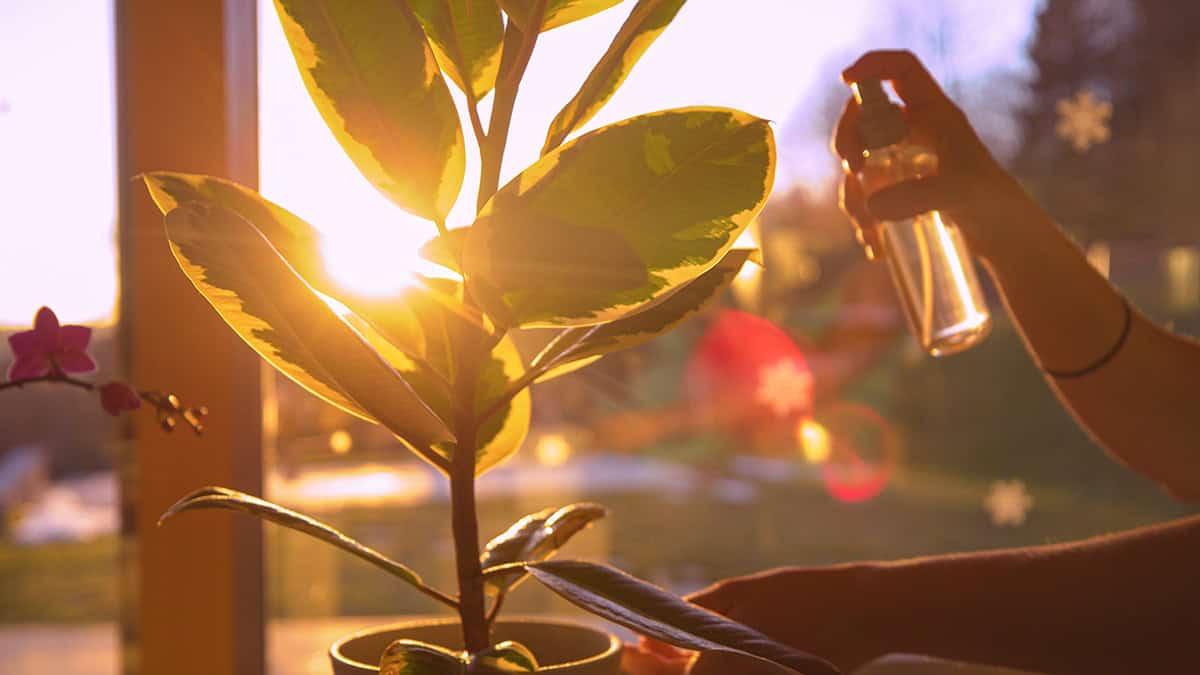
Rubber plants prefer consistent moisture, but overwatering can cause root rot. To prevent this, always allow the top inch of soil to dry out before watering.
When it’s time to water your rubber plant, fill a watering can and pour the water evenly around the base. This will distribute moisture throughout the pot. A good guideline is to water your rubber plant once every 7-10 days, depending on your home’s humidity levels and temperature.
Keep an eye on your rubber plant’s leaves. If they start to yellow or fall off, it could be a sign of overwatering. On the other hand, if the leaves appear to be drooping, your plant might need more water. Remember that humidity plays a role in your plant’s water needs, so consider using a humidifier or a pebble tray to increase the humidity if your home is dry.
Temperature and Humidity
Your rubber plant thrives in daytime temperatures between 70° and 80°F, while the ideal nighttime temperatures are 60° to 65°F. If you can maintain a consistent temperature, your rubber plant will reward you with its lush growth.
While the right temperature is crucial, humidity levels also play a crucial role in rubber plant care. Rubber plants appreciate a high-humidity environment reminiscent of their tropical habitat. You can increase the humidity around them by placing the pot on a tray filled with water and pebbles, allowing the water to evaporate and surround the plant with moisture. Another option is to mist the leaves regularly with water, which helps provide the plant with beneficial humidity.
It’s essential to monitor the temperature and humidity levels in the room where your rubber plant is housed. Sudden drops in temperature or exposure to cold drafts can cause the dark, glossy leaves to wither or drop off.
Fertilizer
To maintain your rubber plant’s health, it’s important to use the right fertilizer. A well-balanced, water-soluble fertilizer with an N-P-K ratio like 16-16-16 can provide essential nutrients for growth. It’s important to dilute the fertilizer according to the package instructions for optimal results.
Your rubber plant will only require feeding every two months during the growing season. Unlike some plants, over-fertilization may not be helpful. To avoid damaging your plant, it’s best to apply the fertilizer sparingly during the spring and summer months. During other seasons, your rubber plant will not require any additional nutrients.
Propagation
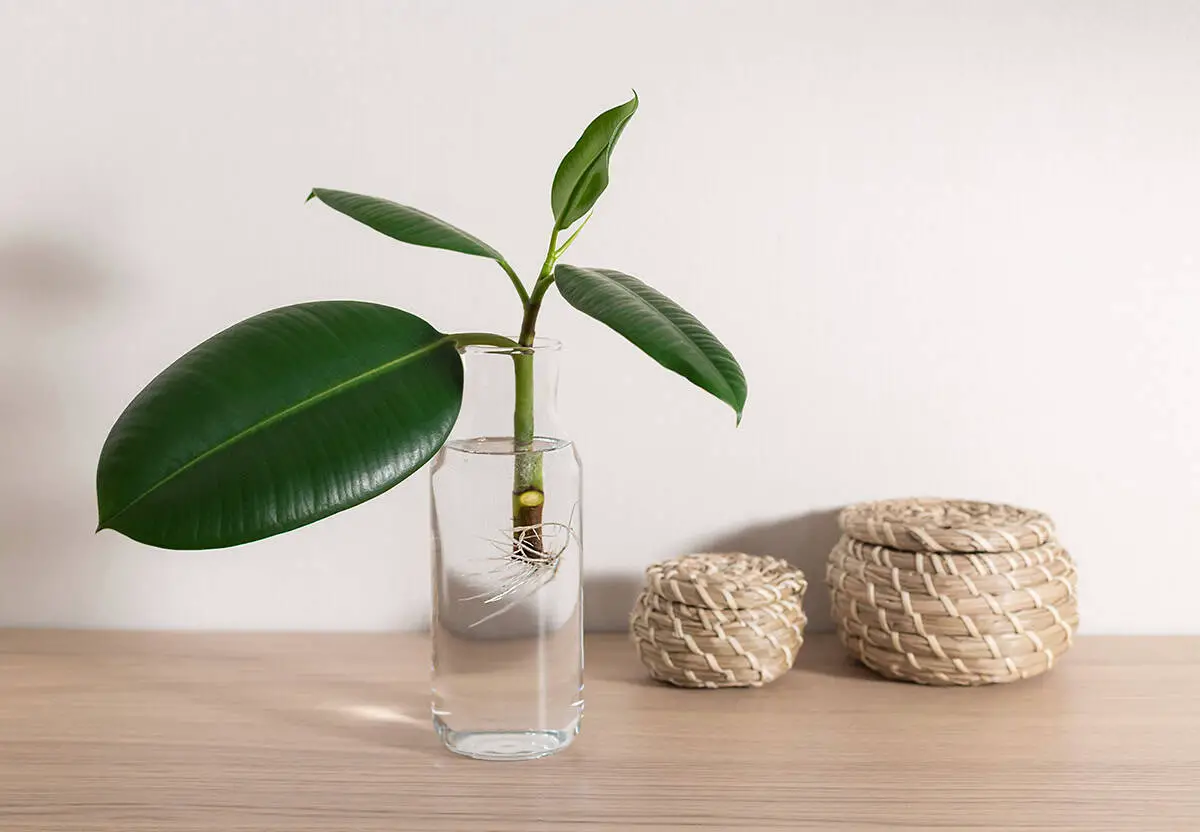
Starting new rubber plants is easy and can be achieved through various methods. Air layering is a popular technique for propagating your rubber tree plant. Select a stem point about 12 to 18 inches from a shoot tip and remove any leaves in that area. Make a cut completely around the stem, penetrating the woody center. This process helps promote new root growth.
Another method is by using stem cuttings. Choose a vigorous and pest-free shoot without any flowers. Make a cut below the node, and dip the cutting in the rooting hormone. Plant it in a moist soil mixture and provide proper care until roots develop.
Be aware that the new plant will be a clone of the parent plant, which means it will retain the same characteristics. Propagation is an excellent way to grow your rubber plant collection and share it with friends or family.
Pruning
Pruning your rubber plant is crucial for its overall health and appearance. It encourages strong branches and a balanced framework, promoting a visually appealing shape. Remember to use clean, sharp pruning tools to avoid damaging the plant and spreading disease.
Firstly, it’s important to understand when to prune. February to early March is the ideal time as the plant is dormant, reducing the risk of stress. To begin, remove dead, diseased, or damaged stems and branches. This improves the plant’s overall health and allows for better air circulation.
Next, focus on shaping your rubber plant. Cut back to a live lateral branch, which should be about ⅓ to ½ the diameter of the removed stem, as mentioned in NC State Extension Publications. This technique is called a reduction cut and ensures the correct branch takes over the lead. Moreover, you can guide the plant’s growth direction by selecting a lateral branch pointing in the desired direction.
Lastly, don’t be afraid to prune more frequently if needed. Regular maintenance enhances growth, stimulates flowering, and rejuvenates the plant. Keep in mind that rubber plants are hardy and can withstand proper pruning.
Potting and Repotting
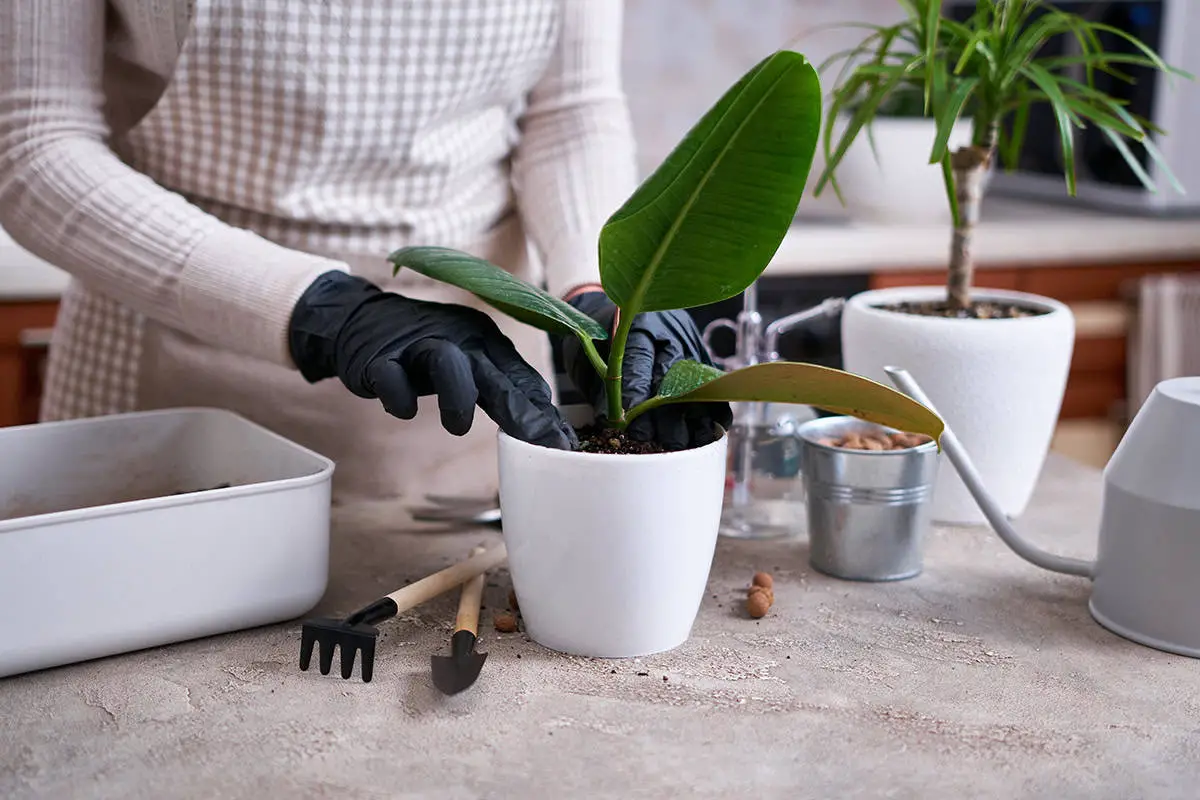
When choosing a new pot for your rubber plant, it is essential to select a container slightly larger than the current one. This will give the roots room to grow and improve overall plant health. You can start by cleaning the new pot and preparing a soil-free potting mix containing organic matter and an inorganic material.
Before repotting your rubber plant, make sure to water it an hour in advance. This way, the plant will be well-hydrated, making the process easier and preventing root damage. Gently lift the plant out of the old pot, taking care not to damage the roots.
Place a piece of broken pottery or a shard over the drainage hole in the new pot. This will prevent soil from leaking while allowing water to drain out. Fill the pot with enough potting mix so that the top of the root ball is about an inch or two below the rim, allowing enough space for watering.
Lower the rubber plant into the new container, ensuring the root ball is seated on the fresh potting mix. Fill in the surrounding space with more potting mix, making sure that the soil reaches the original level on the stem. Firmly press the mix around the base of the plant to secure it, and water well to settle the soil.
Over time, you may notice signs your rubber plant needs repotting, such as a salty crust on the soil surface, top-heavy growth, or drying out quickly between waterings. When these changes occur, it’s time to move your rubber plant to a bigger pot following the steps mentioned above.
Common Problems & Troubleshooting
When caring for a Rubber Plant, you might encounter some issues. Keep an eye out for common problems to maintain your plant’s health.
Firstly, your Rubber Plant might develop yellow leaves. This could indicate overwatering. To correct this, reduce the watering frequency and ensure proper drainage.
On the other hand, if the leaves turn brown and crispy, it’s a sign of underwatering. In this case, increase the watering frequency or use a humidifier.
Another issue is leaf drop, caused by sudden temperature changes or drafts. Ensure your Rubber Plant is kept in a stable environment away from cold drafts, heaters, or sudden temperature fluctuations.
Maintain a temperature range between 60-75°F for optimal growth.
Your Rubber Plant may also face pest problems, such as mealybugs and scale insects. Inspect your plant regularly for any signs of pests.
Treat pest infestations with insecticidal soap, neem oil, or rubbing alcohol on a cotton swab.
Lastly, poor growth and small or misshapen leaves can indicate a nutrient deficiency. Fertilize your Rubber Plant every two months using a balanced, water-soluble fertilizer.
If the plant’s growth still seems stunted, it might be time to repot it into a larger container with fresh potting mix.
Rubber Plant Varieties
Ficus Elastica ‘Robusta’
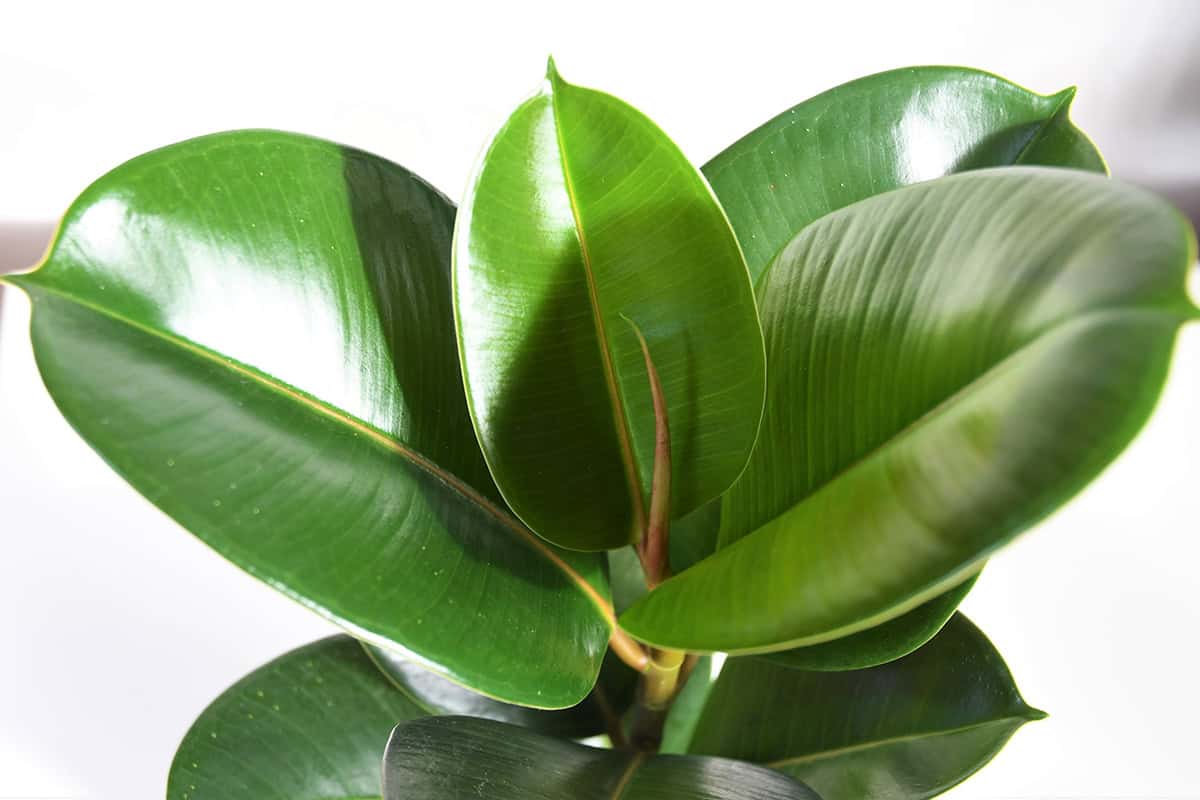
The Ficus Elastica ‘Robusta’ is a popular variety of the rubber plant, known for its large, glossy, and dark green leaves. In contrast to other varieties, it has thicker, sturdier foliage that can withstand lower light conditions. You can easily grow this variety in your home or office, as it requires minimal car.
Ficus Elastica ‘Burgundy’
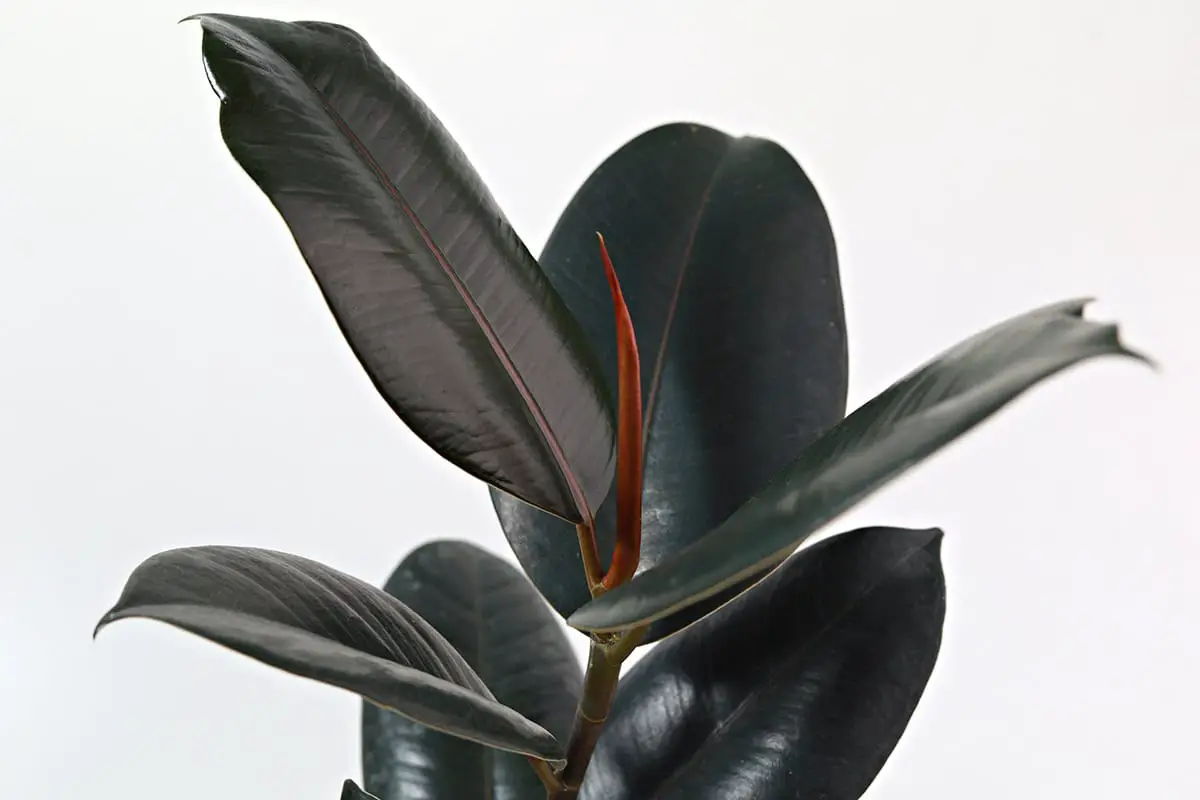
Ficus Elastica ‘Burgundy’ is a beautiful variety with deep burgundy-colored leaves, adding boldness to your indoor spaces. This variety thrives best with bright, indirect light and well-drained soil. It’s also a relatively low-maintenance plant, making it suitable for people with busy schedule.
Ficus Elastica ‘Tineke’
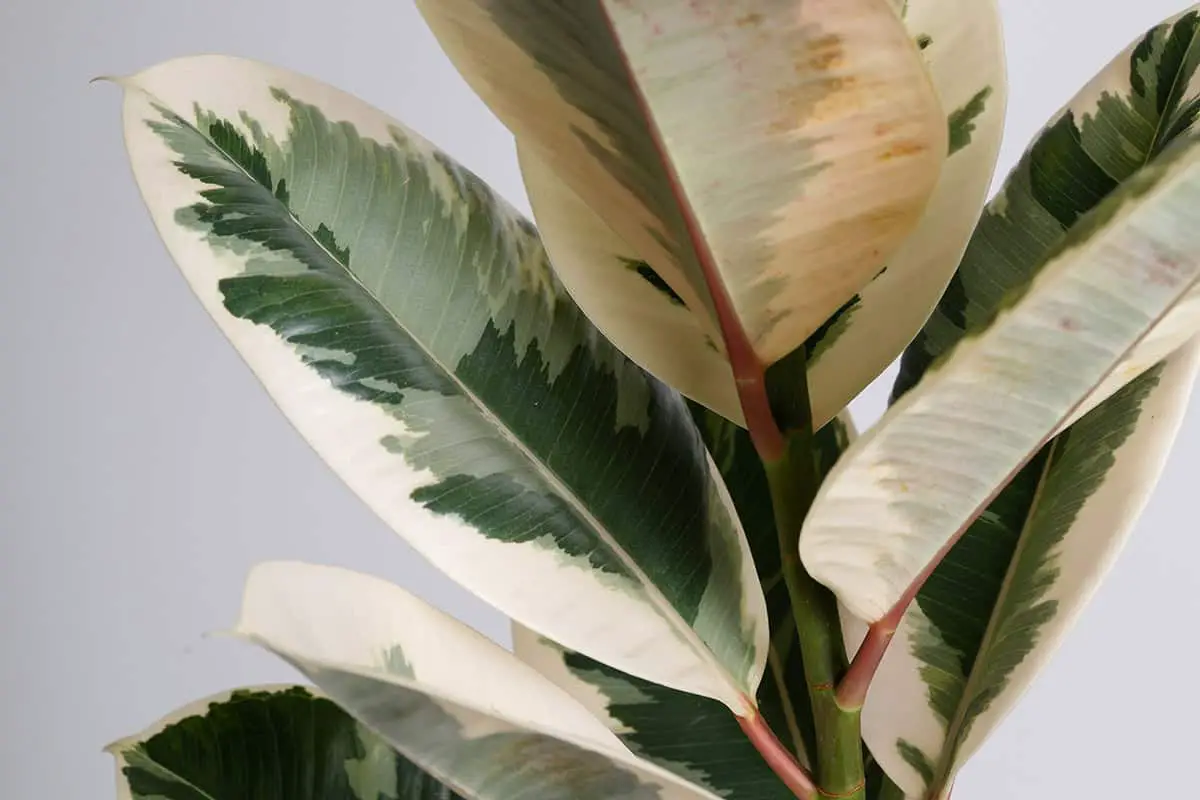
The appealing Ficus Elastica ‘Tineke’ boasts green and cream variegated leaves, giving it a unique look. This variety appreciates bright light but can also tolerate lower levels than its counterparts. Remember to keep its soil moist but not soggy, ensuring adequate drainage to prevent root rot.
Ficus Elastica ‘Ruby’
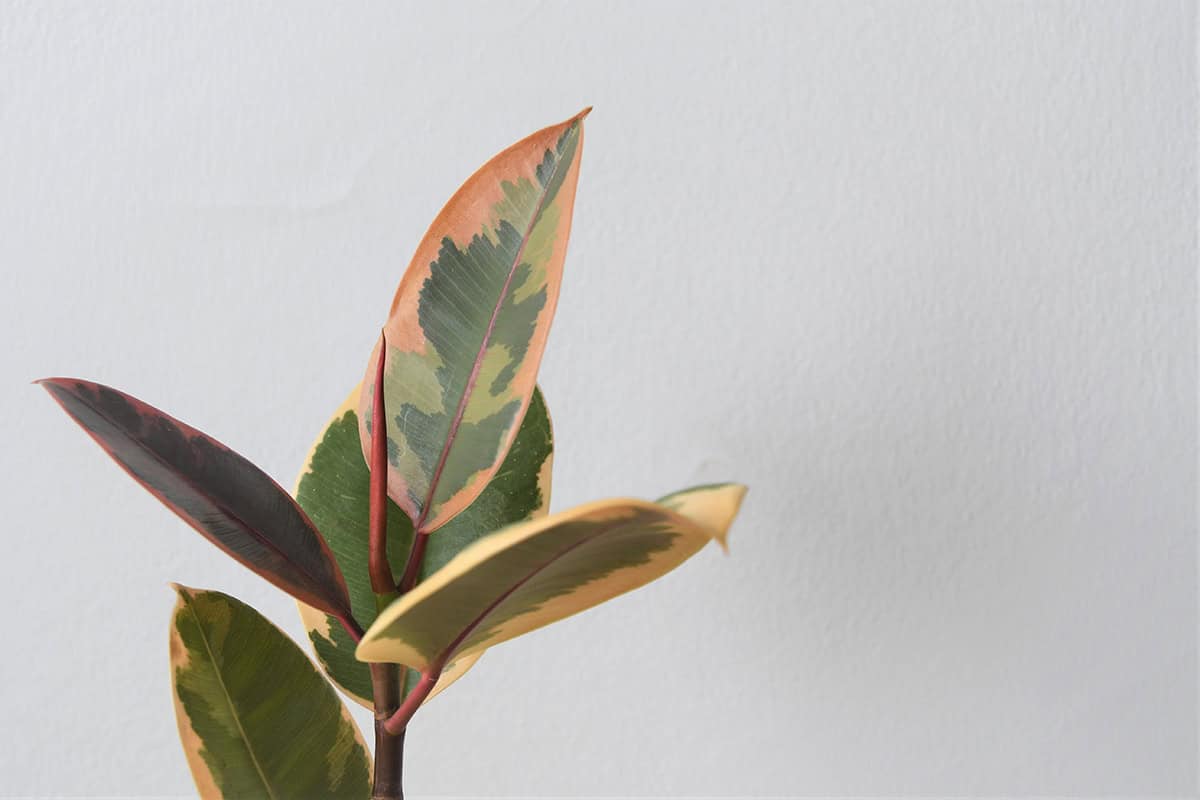
Ficus Elastica ‘Ruby’ is known for its stunning green, pink, and cream-colored leaves. This variety may require a bit more care than others, as it prefers bright, indirect light and well-draining soil. However, the reward of its striking appearance makes the extra effort well worth it.
Ficus Elastica ‘Decora’

A traditional favorite, the Ficus Elastica ‘Decora’ showcases large, dark green leaves with a glossy appearance. It is an adaptable variety that can tolerate different lighting conditions, making it a popular choice for decorating indoor spaces with air-purifying foliage.
Ficus Elastica ‘Abidjan’
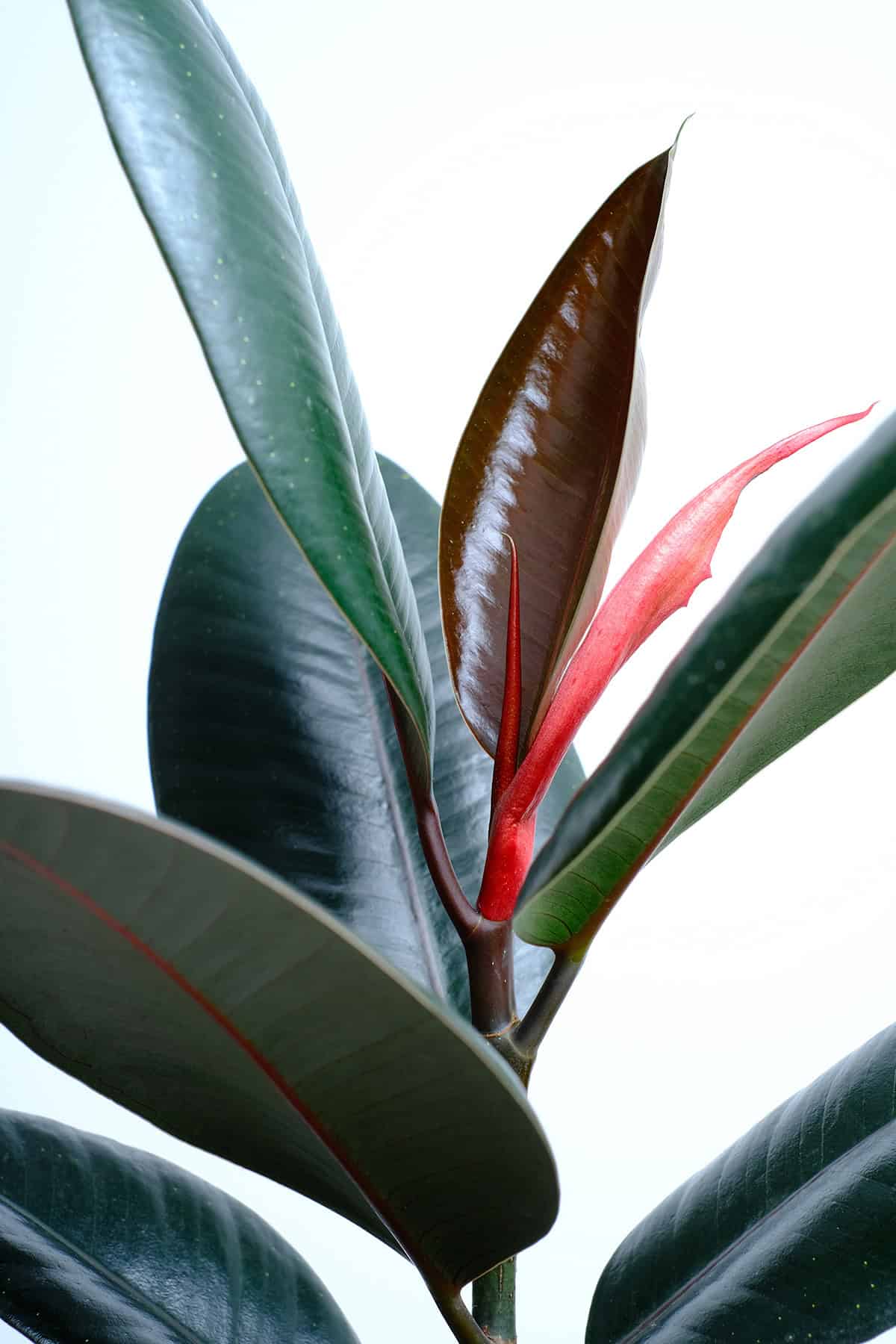
The Ficus Elastica ‘Abidjan’ stands out for its striking reddish-bronze leaves, which gradually become a dark burgundy color as they mature. This variety thrives in bright, indirect light and well-draining soil, creating a visually captivating addition to your home or office.
